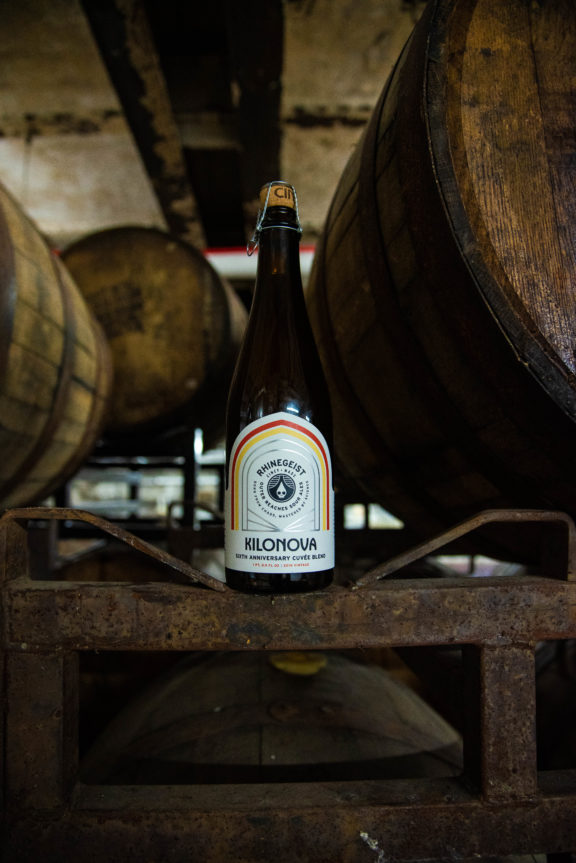Will It Blend?
BLENDING IN
For our sixth-anniversary, Strategic Ops Manager Jeff Martin decided to have a little fun. Fun, for a Strategic Ops Manager, means hosting an internal Outer Reaches blending competition. A collection of some of the most trusted palates in the brewery got together to sip through a panoply of barrel-aged, fruited, sour, and funky beers in order to compose the ultimate senary sensory voltron. This is the story of that blend. But first: blending sours?

BLENDING 101
It’s been said before, but it’s worth saying again: blending barrel aged beer is the pinnacle of the brewer’s art. In blending, the work of the brewer proper is already done and, in theory, the blender is working with a palette of complete or nearly complete beers (save additional bottle-conditioning or discretionary aging components—more on that anon). This allows for the blender’s palate to truly shine; each beer is selected not only for its own salient characteristics but, even more importantly, for its potential interaction with the other beers in the blend. Merely choosing a collection of favored brews and combining them will not allow for the interesting interplay between the strengths and weaknesses of the unique components. To use music as an example, a good blend has a synergy akin to a rhythm, bass, melody, and soloist, and if everyone is just doing their own thing with little or no regard for the other players, the effect can be a little much (that isn’t to say that interesting things can’t happen in either case—think about the difference between the brassy compositions of Sousa and those of Charles Ives for a vivid auditory contrast). Typically, nuance and balance are characteristics that many enthusiasts seek in a blend.

The goal of blending, according to the honorable Dr. Lambic, is “to use a number of individual batches of beer like building blocks to create a final blend that embodies a complexity of aroma and flavor unattainable by a single fermentation.” Blending “marries perfectly with, and indeed developed historically from, the practice of aging beer in wooden barrels. Whether these beers are spontaneously inoculated or more scientifically fermented, the act of aging in relatively small individual vessels will inevitably create differences and varying qualities in each batch of beer.”
Leveraging these specific differences is at the heart of the art of blending. Ideally, the combination becomes a sum greater than its parts, and while it is possible to identify individual characteristics when they are present to consciousness, the overall experience is something entirely new. Creating this experience with intentionality is the task of a skilled blender.
As a rule, we typically look to the older generation of Belgian lambic blenders as the model of contemporary barrel-aged blending. Breweries like Cantillon and Oud Beersel still produce some of the world’s most sought-after blends. While blending is quite common these days at many stateside breweries (and becoming more so), the one hundred-plus years of experience and bottling programs founded around the art of blending shows there’s still a lot to learn from the approach and technique of the Belgian trailblazers. Thankfully, a lot of attention has been paid to them, and we can all reap the tasty benefits.

KILONOVA: THE WHOLE ENCHILADA

A kilonova, as described by Tanvir et al., is a transient astronomical event resulting from the merger of two compact stellar objects—specifically two neutron stars or a neutron star and a black hole. Staying within the overarching theme of the Outer Reaches collection—the struggle between science and innovation; part theoretical physics, part metaphysical speculation—the union of a star and a black hole stood out as the perfect name for our sixth-anniversary blend: matter and perception merge to become one.
Rose gold with medium haze and minimal head retention, Kilonova is as refreshing as it is enigmatic. The flavor of Kilonova is very fruit forward with medium acidity and a body on the lighter end of the spectrum. Although Kilonova is extremely dry, the fruit gives a slight impression of lingering sweetness.
The final blend, which happened to be Jeff’s own, is as follows:
40% – Ale with Apricot & Nectarine
21% – Ale with Plum, Pineapple, Passionfruit, Apricot, & Guava
21% – Blonde Sour Base with Roeselare blend (white wine like)
9% – Cherry Kriek
9% – Tequila Barrel Aged Infinite Dawn
“My goal with Kilonova was to create something uniquely complex, yet balanced and bright,” Jeff explains. “My main focus was to start with what I consider the best beer, and use that as the foundation for the blend. Once I identified what I thought was the base beer, from there it was mostly a ‘sense it out’ type approach, in which I play off the strengths of the base.”
Jeff likens this to the way he approaches cooking in general and notes that his enchilada game has greatly improved since the Kilonova blending session.

Jeff and his winning blend.
CONCLUSION
Kilonova will be hitting shelves starting next week, and we hope to continue exploring the exciting and always evolving world of barrel aged beer blending in the future. Until then, stop by our sixth-anniversary celebration on 6/29 and try some Kilonova along with a rotating bevy of rare and exceptional beer from our secret cache. Blend on, blendarinos.




